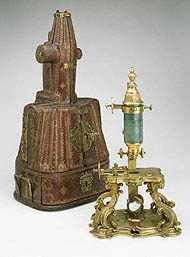 |
 |
 |
 |
Grades/Level: High School (9–12)
Subjects: Visual Arts
Time Required: 2–Part Lesson
Two to three class periods
Author: J. Paul Getty Museum Education Staff
Permissions: 
The lesson plan and downloadable materials on this page are licensed under a Creative Commons Attribution 4.0 International License. |
 |
|
 |
 |
 |
 |
 |
 |
 |
Lesson Overview |
 |
Students will discuss the style and function of an 18th-century compound microscope and its case and then design their own modern scientific or technological instrument. |
 |
 |
 |
 |
 |
Learning Objectives |
 |
Students should be able to:
• discuss and analyze the elements and principles of design as seen in the Compound Microscope and Case.
• discuss and compare the design of the microscope to the design of modern scientific or technological devices.
• apply the elements and principles of design to the creation of their own modern scientific or technological device.
|
 |
 |
 |
 |
 |
 |
 |
 |
 |
Materials |
 |
• Image of Compound Microscope and Case attributed to Jacques Caffieri
• Drawing paper
• Drawing pencils
• Colored pencils
|
 |
 |
 |
 |
 |
|
|
 |
 |
 |
 |
 |
Lesson Steps |
 |
1. Click on the thumbnail of the image above for information and "Questions for Teaching" about the microscope and its case.
2. Discuss the use of line, form, unity, balance, and harmony in the decoration of the microscope. Also discuss the use of texture, for example, the shagreen (sharkskin) on the microscope and the tooled leather on the case.
3. Compare the Compound Microscope and Case to the design of modern scientific or technological objects. Think about computers, cell phones, PDAs (personal digital assistants), handheld CD players, or stereos.
• What elements of design do you find in these modern objects?
• How are they similar to, or different from, the design used on the microscope?
• The gold on the microscope adds unity to the design. In what way is color used in the design of modern scientific objects?
• How does the design of the modern objects you discussed add to their function?
4. Have each student in the class choose a modern scientific or technological device and create a design for it. Make sure they are careful that the designs they create for their objects don't interfere with their function. Students should also design cases for their objects, keeping in mind how the cases will integrate with the overall design.
5. Students will use drawing paper, pencils, and colored pencils to create their designs for their objects and cases.
6. Have students write an explanation of their ideas for the design of their objects. They should use the vocabulary associated with the elements of art and principles of design to discuss the choices they made in the design of their objects and how these choices affect their object's function. |
 |
 |
 |
| Compound Microscope and Case, Jacques Caffieri, about 1751 |
 |
|
 |
 |
 |
 |
 |
 |
 |
Assessment |
 |
Students will be assessed based on the completion of the assignment, how it functions as a result of their design, and their written explanation of their design choices using art vocabulary. |
 |
 |
 |
 |
 |
Extensions |
 |
In the 17th century, microscopes opened up the world of scientific exploration. Robert Hooke (English, 1635–1703) was the first to apply the word cell to plant materials he observed under a microscope. His book Micrographia or, Some Physiological Descriptions of Minute Bodies Made by Magnifying Glasses combined art and scientific research. Hooke drew enlarged images of fleas, flies, and other plant and mineral specimens. With your class, create your own Micrographia. Have students examine and classify specimens under a microscope and then make their own enlarged drawings that can be compiled into a book.
Visit the Devices of Wonder Web site to explore the microscope in detail. You can turn it around, open the drawers, and look at the accessories inside the case. |
 |
 |
 |
 |
 |
 |
 |
 |
 |
Standards Addressed |
 |
Common Core Standards for English Language Arts
Grades 9–12
SPEAKING AND LISTENING
Comprehension and Collaboration
1. Prepare for and participate effectively in a range of conversations and collaborations with diverse partners, building on others' ideas and expressing their own clearly and persuasively.
2. Integrate and evaluate information presented in diverse media and formats, including visually, quantitatively, and orally.
Visual Arts Content Standards for California Public Schools
Grades 9-12
2.0 Creative Expression
Creating, Performing, and Participating in the Visual Arts
Skills, Processes, Materials, and Tools
2.1 Solve a visual arts problem that involves the effective use of the elements of art and the principles of design.
3.0 Historical and Cultural Context
Understanding the Historical Contributions and Cultural Dimensions of the Visual Arts
Role and Development of the Visual Arts
3.2 Identify and describe the role and influence of new technologies on contemporary works of art.
|
 |

|
 |
 |
 |



